The following posts are the report of our tour from Darwin to Arnhem Land and home again in August 2019. Due to the remoteness of Arnhem Land and the potential difficulty getting permits we’ve joined a tag-along tour run by Great Divide Tours. While Priscilla (our Trakka Sprinter 4WD) would have made the trip very comfortable for us, we were rightly concerned that due to her length and height she wouldn’t have managed the smaller side tours we did. We’re in the Pajero with a free-standing, small tent.
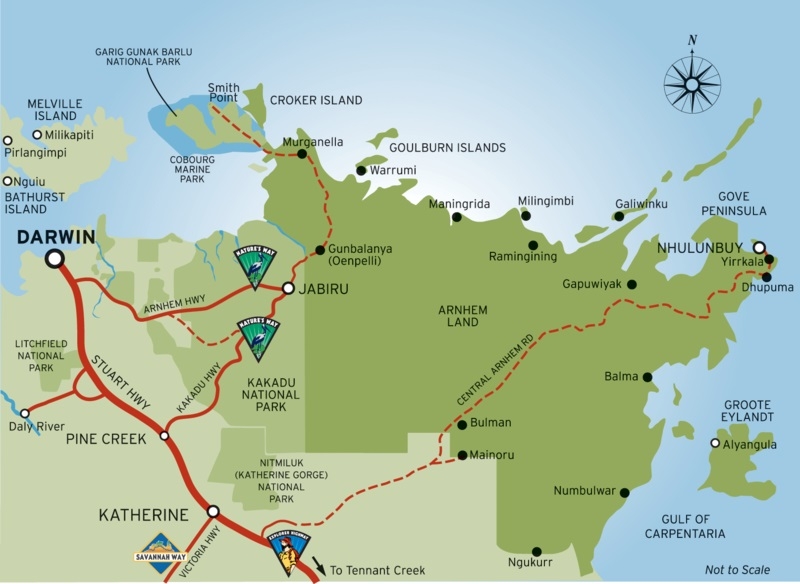
Note the National Park and Smith’s Point shown at the northern part of the map and follow the Central Arnhem Highway to Nhulunbuy in the east, both areas we visited.
Arnhem Land is in the north east of the Northern Territory, with its northernmost point only marginally more south than Cape York, Australian mainland’s most northern point. With an area of 100,000 sq km it’s larger than Hungary, Portugal or Austria. However total population for this very remote area is only around 16,000 people, 12,000 of whom are the traditional land owners, the Yolngu people. Arnhem Land was named after the Dutch ship Arnhem which navigated across this coastline in 1623. We know we are privileged to be able to access this very remote area of the World, the indigenous communities and people who live here.
Did you know Arnhem Land is the home of Australia’s most famous instrument, the didgeridoo?

Gratuitous photo of a didgeridoo. Image from wikicommons
Sunday 28th, Monday 29th July 2019
Darwin
Yesterday I finished walking the 65km Jatbula Trail in Nitmuluk NP with some friends, and am now in Darwin. Meanwhile Steve and his mate Nigel left home a week ago to drive to Darwin from Brisbane via Birdsville.
I farewelled my walking buddies as they headed to the airport and I walked over to the Ramada Zen Hotel (ONLY 2.5km, easy!) to await Steve and Nigel. By all reports they had a brilliant trip. Relaxing, catching up on our experiences, drinks and dinner at the Penthouse (barramundi) before an early night finished that day.
Monday we drove out to the War Museum at East Point. It is very well curated and had lots and lots to see both inside the museum and outside in the grounds, including the big 9 inch guns and lots of personal stories from civilians and military personnel in Darwin 1942. An excellent documentary style film portrayed the events of February 19 1942, the day war came to Australian shores with the bombing of Darwin by the Japanese. I was here particularly looking for a photograph of my mother who was an army nurse during WWII and stationed in Darwin. I think I’ve found the one I’d been told about.

Maybe mum is the one third from the right in the middle row. Though she was a registered nurse so I’d expect her to be wearing a veil. Perhaps she’s the nurse sitting in the front row, second from the right.
From there we headed into Darwin and wandered the streets and malls finally settling for lunch on the lawn overlooking the ocean at the Speakers Corner cafe in Government House. Wonderful location!
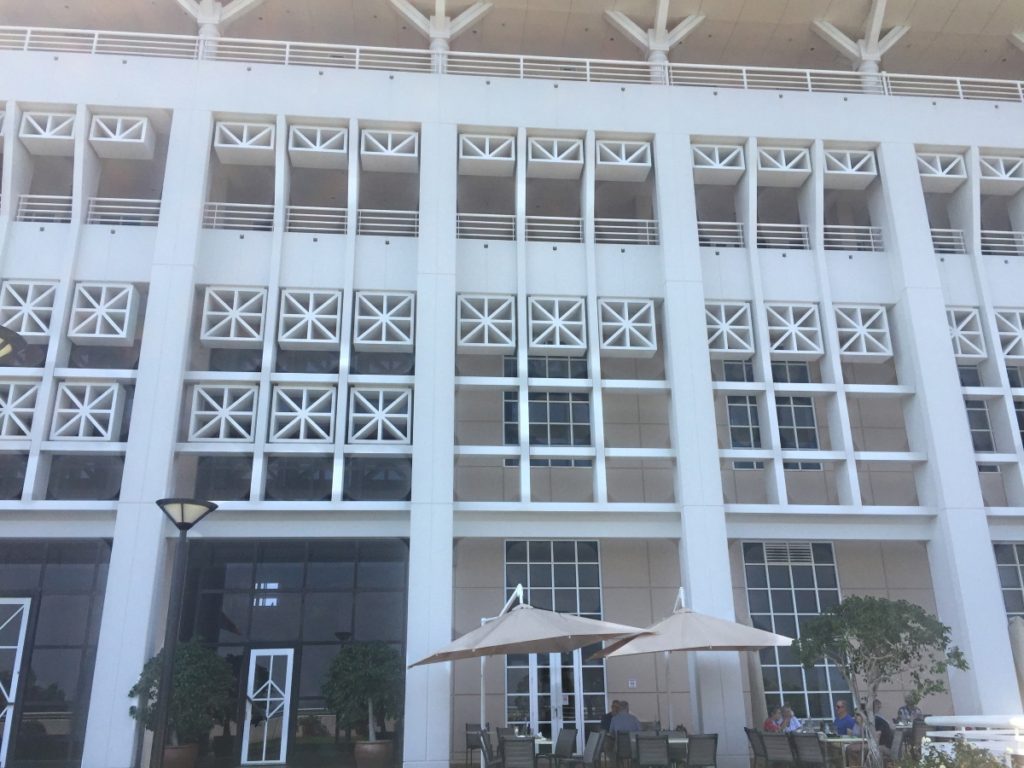
We’re sitting under those umbrellas enjoying the view of the ocean, which is over the shoulder of the photographer. A lovely building, designed beautifully for the climate.
Later in the afternoon we went to the joint RFDS / War Memorial building on Stokes Wharf. Here there was a virtual reality portrayal at the time of the bombing and also a good hologram depiction of the actions of a US naval captain whose ship was in harbour at the time of the bombing.
We finished the day at Crustaceans restaurant on the wharf where we all relished the joy given by a whole chili crab each. Fantastic!

Kakadu
Tuesday 30th – Friday 2nd August
This morning Nigel flew back to Brisbane, and Steve and I provisioned the car before heading to Kakadu NP via the Kakadu Highway. We’re camped in the tent at Gunlom for two nights. I tried to talk Steve into going tent-free (as I had been during our Jatbula walk) but haven’t achieved it yet.
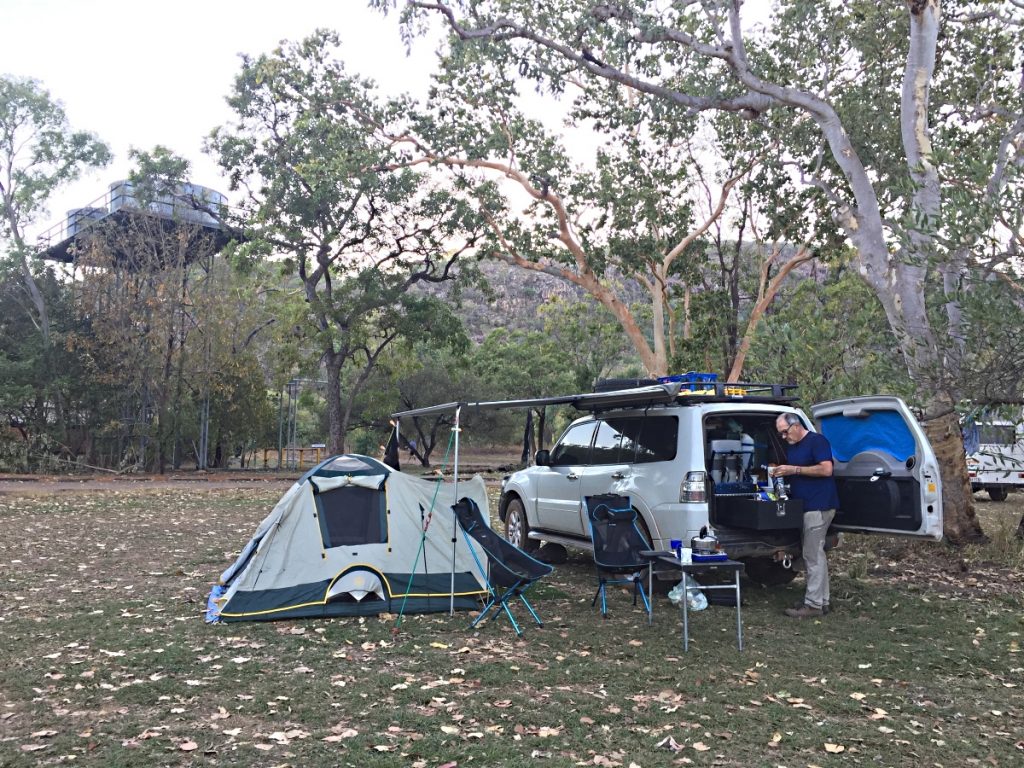
Our campsite at Gunlom. The infinity pool is at the top of the hill in the background. A lovely clear, sandy pool is at the base, off to the left of our campsite.
Gunlom brings back very happy memories from the last time we were here with Ric and Gill. However this time the road in, supposedly a 2WD road, is very badly corrugated and due to a poor “wet” this year the creek feeding the infinity pool is low, hence not a great flow through the pool nor over the escarpment. And the upper ¾ of the steep path to the infinity pool is a temporary one scrambling over rocks, hanging onto saplings, and even steeper than the original which is being replaced with steps.

The track up to Gunlom infinity pool – challenging!
The pool itself and view are as spectacular as ever, however the pool is green and the many submerged rocks very slippery. Not the picture postcard perfect experience the tourist is led to expect. Mind you over the two days we’ve been here we haven’t seen any tourist busses pull in. The plunge pool at the bottom of the falls, however, is as spectacular as ever, crystal clear and chilly and an enjoyable swim.

Gunlom infinity pool, still a magnificent pool despite the dry weather. You can see the small waterfall that leaves this pool at the far end.
After a dip in the plunge pool on Thursday morning we moved closer to Jabiru, which is where we will join our Arnhem Land tour. On the way we stopped to look at the Warradjan Aboriginal Cultural Centre. This well curated very interesting centre is well worth a visit. Cooinda, our camp for the night, is a very large, very busy, privately owned caravan park that I wouldn’t recommend. Friday we moved on to the township of Jabiru. This little town used to be the centre for the Ranger Uranium Mine until it closed down several years ago. There are many closed shops and it’s beginning to look neglected, except for the tourists that keep it going. As it is on Aboriginal Land the mine was granted a limited time lease for the town. That has been extended once for another 5 or 6 years, and there is a feeling it may not be extended when it comes up again – time will tell.
We restocked our food at the local supermarket, which was pretty good, considering. We booked into the cabins in the caravan park (not salubrious), did some washing and rested in the air conditioning – not that it’s hot, unless you’re in direct sun with no breeze.
This evening we met the group we’ll be travelling with for the next three weeks then we all went over for a meal at the bistro – lovely tender pork for me, steak for Steve. Tomorrow our trip begins.
Garig Gunak Barlu NP (Cobourg Peninsula)
Saturday 3rd – Tuesday 6th
8 4WD of all different types lined up this morning, with Neill Bell from Great Divide Tours, our tour leader, in the front. About 40km out of Jabiru we all “aired down” to 28 and crossed Cahill’s Crossing which had about half a meter of water flowing over; and we saw our first crocodile.

Cahill’s Crossing. The crocodiles are further upstream. Apparently as the high tide flows out the crocs sit at the edge of the crossing and pick off the fish as they are swept over the causeway.
That ended the black top. Our road varied over the next 250-odd kilometres between smooth and badly corrugated dirt or sand with washouts and bulldust holes.

The whole Cobourg Peninsula comprises the Garig Gunak Barlu NP. This extensive park includes the surrounding waters of the Arafura Sea and Van Diemen Gulf, and some of the neighbouring islands.

Another water crossing on the way. (Paul and Julie’s car)
We stopped to view points of interest, have a coffee break, collect wood for a fire and “Sturt” stops (think of the pretty red flower that grows in the desert).
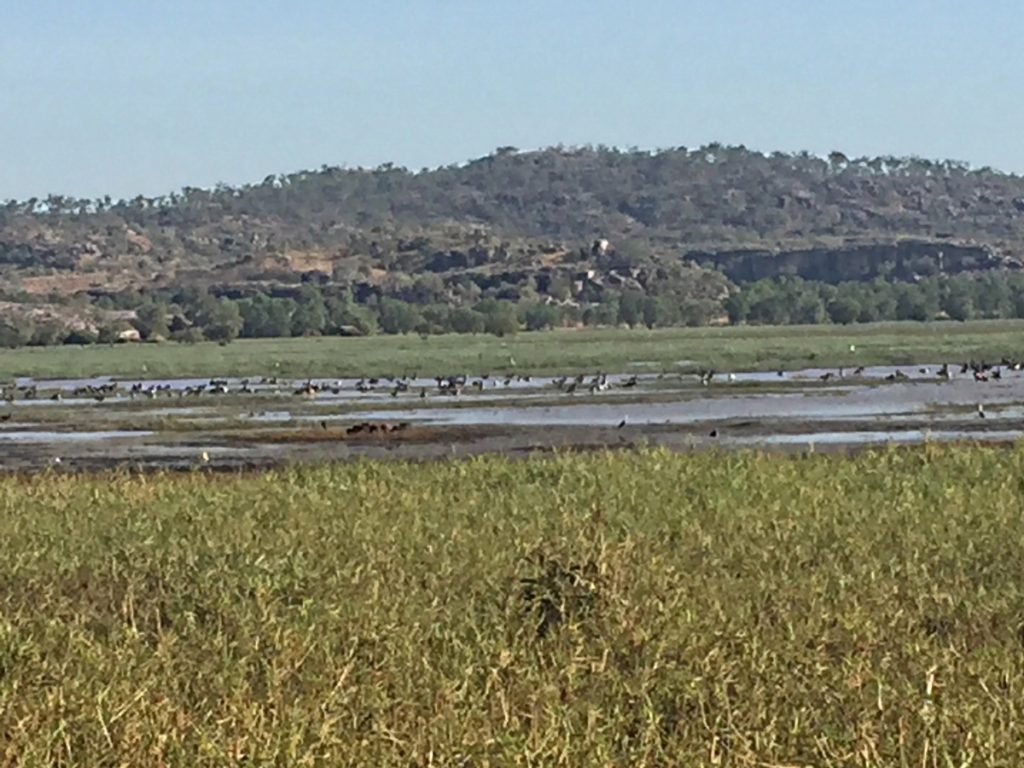
Lots of birds at these wetlands. Garig Gunak Barlu NP
Our campsite (cold showers, long-drop toilets) is right at the beach at Smith’s Point at the head of Port Essington and is exclusive to our group. Our site looks directly onto the Arafura Sea. After watching a spectacular sun set into the ocean, meals were cooked on the big gas BBQ that Neill fires up each night, then we all settled down around the fire for a yarn. A good first day.
Sunday Steve and I and 4 others (Mark, Katie, Steve and Jo) went down to the jetty to join our fishing trip. Wow! That was exciting! Travis, the skipper, flicked a line out at the end of the jetty and straight away pulled in a decent sized trevally which was our bait. First spot we stopped the lines weren’t in the water for more than 3 minutes before Steve got a BIG strike. It took him about 10 minutes to bring it in as it pulled him all around the boat – a very good sized Jew fish.

Steve’s ‘catch of the day’ – a jew fish
It wasn’t long before Mark also caught one, maybe even bigger. Then it was my turn with a “queenie” that gave me a workout and measured about 1.5 metres long. We moved to a few different spots and mostly caught and released what we caught after that, except for a beautiful big coral trout. It was rough on the water with 30 knot winds gusting stronger, but the excitement of the trip over-rode the rocking and rolling.

Travis, our very competent fishing teacher, filleting one of the many fish we caught.
Everyone had BBQ’d fish for dinner tonight.
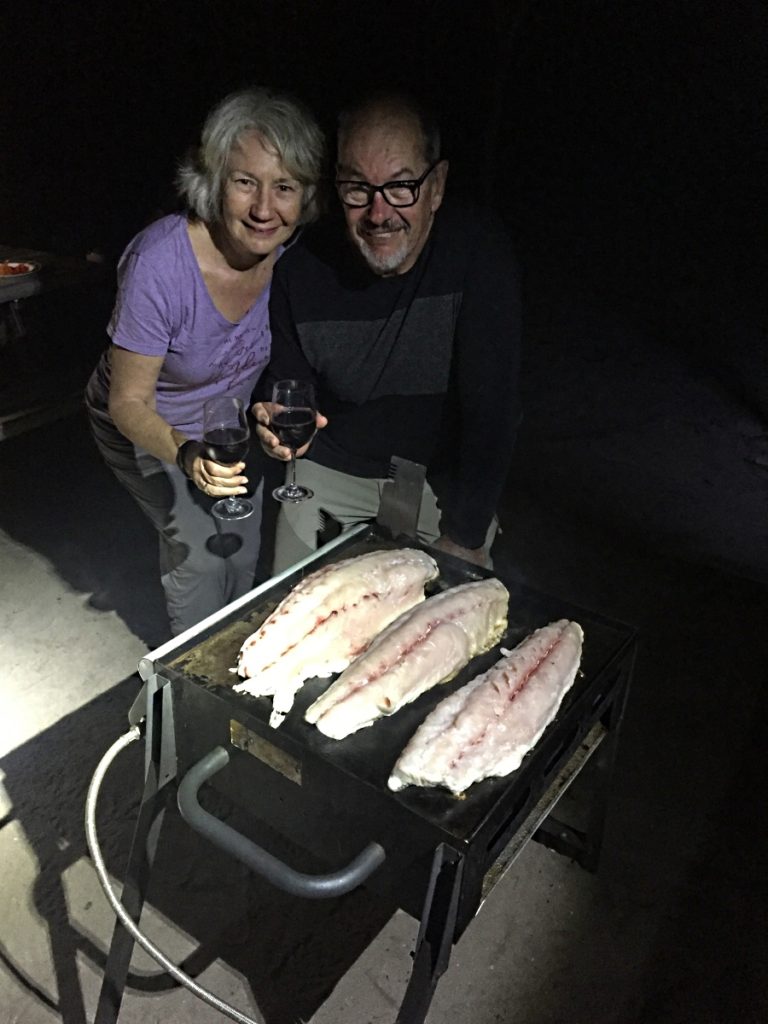
Enjoying the fruits of Denise’s labour – Queenie on the barby.
In the afternoon we did a scenic drive, in convoy, around the Peninsula along narrow, two-tyre-track tracks that hugged the magnificent coastline for awhile before we went inland to see the wetlands. These wetlands received Ramsar accreditation in 1992, designating it as a “Wetland of International Importance” because of its diversity of coastal and inland wetland types, support for populations of threatened species including a number of endangered turtles, maintenance of regional biodiversity, support for life-cycle functions such as turtle and waterbird breeding and refugia values, and for providing important fish nursery and spawning habitats. There are now some 65 Australian wetlands recognised under this convention, however this was Australia’s first.
The previous wet season up here is one of the worst (ie poor rainfall) in recorded history and though the wetlands are significantly reduced the bird life was still prolific. I’d have loved to be here at dawn or dusk to see the birds. We drove back around the coastline then across the Peninsula and back to camp. A good drive and great to see more of Cobourg Peninsula.

Lots of birds at these wetlands. Garig Gunak Barlu NP
Monday was a quiet morning at camp before once more we joined Travis on the boat this time to go to Victoria Settlement, an army garrison set up in 1838 to warn and protect the new colony of potential threats from the French and the Dutch and to encourage Asian trade. It was a very comprehensive settlement with beautifully built stone officer’s quarters, a kiln, hospital, quartermaster’s stores and munitions store. National Parks has created a 4 km walk around the site. Some of the buildings were so well constructed that much of them remains in very good order.

The chimney stacks and fireplaces for cooking are all that remain of the Officers’ homes. Victoria Settlement
It was an ill-fated settlement with many deaths and was finally abandoned after only 11 years. However in its day it was very busy with Macassans coming down from Sulawesi as they had done from as early as the mid-1700’s to trade with the many aboriginals who lived around there. In exchange for fishing rights, turtle shell and pearls the Macassans traded cloth, tobacco, metal axes and knives, rice and gin. They predominantly harvested and dried the trepangs (sea cucumbers) for culinary and medicinal use. A lasting legacy is the number of tamarind trees planted by the Macassins that remain today. Travis told us that there was a lot of mixing of the cultures and that aboriginals had already been travelling to Sulawesi, Asia and even Holland as the Dutch traded here too. Intercultural marriages occured both here and in the destinations to which they travelled. We’re learning a lot of Australian history that is not widely known. Another excellent excursion, made all the better for the incredible knowledge Travis shared with us.
More BBQd fish and another big fire tonight.
Tuesday was a restful morning for us while one group went fishing in the morning and another in the afternoon – yep, heaps more fish, Jew fish and coral trout. A trip to the Aboriginal Cultural Centre gave us more perspective with displays describing the life and a little history of the indigenous people, the Macassans and the Victoria Settlement. Caiman Creek, some 20 km down the corrugations was good for fishing for some, while we enjoyed a walk to the mouth of the creek to view the cliffs.
During our travels we occasionally spotted the elusive Banteng, a feral cattle native to Asia, that was released when Victoria Settlement was closed in 1848. These cattle are endangered in Asia with few numbers and no longer any pure bred, while these in Arnhem Land are very pure and thriving. It’s become an issue for the conservationists trying to protect the National Park and those conservationists trying to protect an endangered species.
Alan, has been the Ranger here for 34 years – there’s not much he doesn’t know about the area. He chatted with us around the campfire tonight sharing a wealth of information. One of the many advantages of doing this trip with a company that has a long and well-respected association with the area.
Wiligi Outstation
Wednesday 7th – Thursday 8th
Leaving the Peninsula and National Park we travelled 140 km to our destination for the next two nights, Wiligi Outstation, a small tourism venture with camping and a few cabins, owned by one of the Traditional Owners. This is another spectacular campsite with our tent barely 20 metres from the high tide line.

Our campsite from the boat. Our tent is on the far left, between the two pandanus palms.
We had a boat hired for the day for fishing or going out to explore Copeland Island. Steve chose to stay in camp reading, listening to music (and the gentle lapping waves); I took the opportunity to go to explore the island with Pat and Dick (Neill took us over in the boat), climbing to its peak to get 360° views. Beautiful.
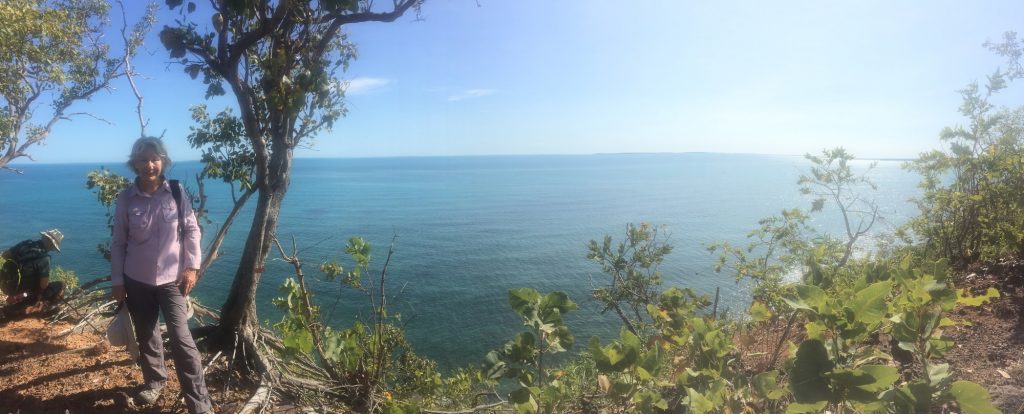
Taken from the highest point on Copeland Is, with Dick to the left of the photo.

Sunset alongside our campsite at Wiligi Outstation.
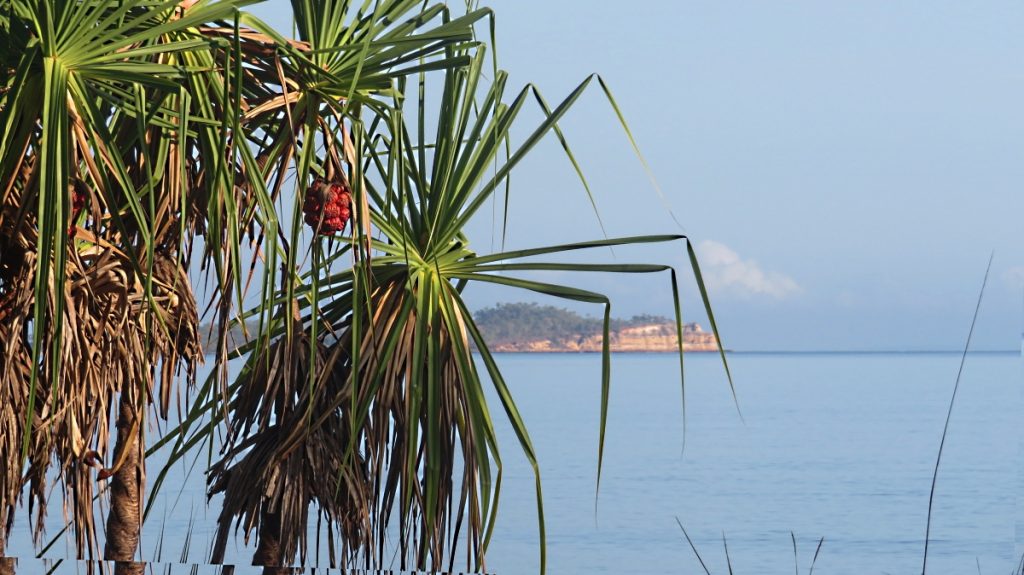
Pandanus Spiralis or ‘screw pine’ at Wiligi. The Indigenous Australians use the strappy leaves for weaving and the fruit (the big orange fruit you can see) has a tasty nut, though it’s hard to access. The base of each leaf is white and apparently tastes a bit like cabbage. The dead trunk can be made into a didgeridoo and as it burns slowly the Indigenous people would use it to carry fire from one place to another. A useful plant.
Friday 9th
Leaving Arnhem Land for the time being we return to civilisation today. We retraced our outward journey, via another wetland before stopping in at Gunbalanya (Oenpelli) where, unfortunately, the Art Centre was closed. The major Art Awards are on in Darwin and many of the artists and their works are currently there. However there were a few artists sitting around painting or weaving outside the centre so we wandered around observing them.

Weaving a dilly bag from pandanus leaves.
Back over Cahills Crossing and into Jabiru where we had lunch by the lake, a minor restock and refuelled.
We followed the blacktop through Kakadu NP on the Arnhem Hwy. Outside the NP and at a very inconspicuous spot on the highway at Mt Bundy is the turnoff to an amazing granite sculpure ‘park’ celebrating the importance of wild rice as a staple food for indigenous peoples for centuries as well as its importance as a sustainable food crop for the future. The wild rice of northern Australia is genetically pure. The sculptures were created by an elderly Japanese artist, Mitsuaki Tanabe and are epic in their proportions, the longest being a wild rice sheaf 82 metres long carved in the granite ridge.

Viewing the extent of the granite carving of a wild rice sheaf. Mt Bundy
Tonight we’re camped at the privately owned Corroboree caravan park for the night. It was very full and very noisy! Ahh, but the joy of freshly laundered clothes can’t be underestimated. Dinner tonight was at their restaurant with the group – salt and pepper calamari for me.
We’re all looking forward to the next part of our adventure in a couple days when East Arnhem Land will be the highlight.
To see more photos from this part of our trip CLICK HERE.

